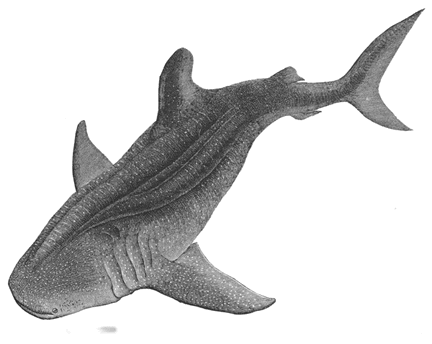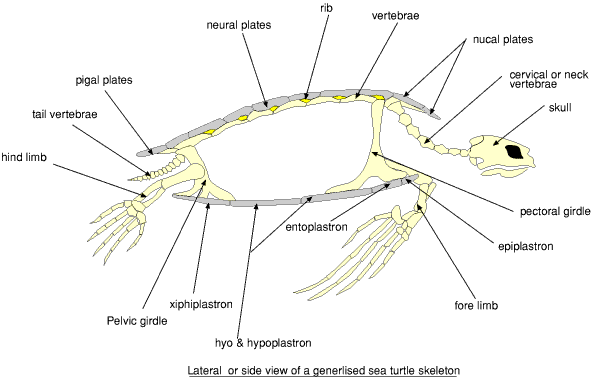Very controversial, yes, very much so! The reports of "plesiosaurs" continue to surface no matter how strongly many scientists maintain that they are extinct. The presented photos and sketch from the netting by a Japanese trawler near New Zealand in 1977 triggered a long standing disagreement as to what it was. A plesiosaur, a rotting carcass of a basking shark (see http://members.aol.com/paluxy2/plesios.htm) , a unidentified species resembling a non-shelled sea turtle, or what? It sure dosen't resemble a shark, especially the view of it laying on the deck.
The explanation is as follows. When basking shark carcasses begin to decompose, the entire gill apparatus falls away, taking with it the shark's characteristic jaws, and leaving behind only its small cranium and its exposed backbone, which have the appearance of a small head and a long neck. The triangular dorsal fin also rots away, sometimes leaving behind the rays, which can look a little like a mane--especially when the fish's skin also decays, allowing the underlying muscle fibers and connective tissue to break up into hairlike growth. Additionally, the end of the backbone only runs into the top fluke of the tail, which means that during decomposition the lower tail fluke falls off, leaving behind what looks like a long slender tail. The pectoral and sometimes the pelvic fins remain attached, but become distorted, so that they can (with a little imagination!) look like legs with feet and toes, and male sharks have a pair of leglike copulatory organs called claspers, which would yield a third pair of legs. And reportedly one interesting aspect of the transformation from basking shark to mystery carcass is that as the shark decomposes its fibrous muscle tissue takes on the appearance of a white hairy coat. Suddenly, the basking shark has become a hairy six-legged sea serpent, or whatever!!
This explanation however implies that that the ship's biologist was mistaken in many areas, even so obvious an observation that the carcass had four flippers approximately equal in size. However, it is known that the biologist made the sketch from memory approximately two months after the incident and it includes bone structures in the flippers which don't appear to be visible in the photos. And also some biologists claim the size, fin placement, and overall appearance does not support the basking shark theory. So the mystery continues, with probably the majority of scientists favoring the decomposed basking shark as the mostly likely explanation.

Plesiosaurs were an important group of marine reptiles during the age of dinosaurs. They appeared to be very well adapted for life in the oceans. One group of plesiosaurs, generally referred to as 'elasmosaurs', had short tails and long necks, while others had very long necks and tails, looking more like a snake with four flippers.. Pliosaurs, on the other hand, most generally had a short neck and a relatively large head. In both groups, the body was broad and relatively compact, with closely set, strong ribs and well developed gastralia (belly ribs) to protect / stiffen the abdomen. They had well developed, paddles which were the main means of propulsion. Recent studies of plesiosaur paddles have shown that, instead of being pulled back and forth like oars on a rowboat, they were 'flapped' up and down much like the wings of a bird or the paddles of a turtle. The plesiosaur, in effect, possibly 'flew' through the water like a modern penguin. Plesiosaurs ate fish, small ammonites and other invertebrates. Many specimens have gastroliths or stomach stones in their abdomens. There is still some controversy about whether or not they laid eggs, but evidence found in South Dakota and Kansas seems to point toward plesiosaurs giving live birth. It is hard for some to imagine a forty-foot plesiosaur struggling up on a beach to lay eggs like a sea turtle. There are probably several good physiological reasons (such as over-heating, and not being able to breathe) why egg laying would not be possible in plesiosaurs, but there is still as usual much uncertainty.

The resemblence of the carcass laying on the deck to the soft parts of a sea turtle is obvious, that is those parts which can be seen in the photo. The shelled sea turtle has a skeleton that would seem to be considerably different than that of the sketch of the ship's biologist as the below generalized sea turtle sketch shows.

Not exactly a dragon, but the classic case of a species believed to be long extinct and then discovered is the coelacanth. First located in December 1938 near the mouth of the Chalumnae River off the coast of East London, South Africa. And a second in December 1952 in the waters of the Comores, Adjouan Island. Since 1952 over 190 recorded catches have been made in the Comores region. In 1995, one specimen was caught off Madagascar. In 1998, two coelacanths were caught at Sulawesi, in the Indonesian Archipelago. DNA comparison indicated that the Indonesian coelacanths seem to be a separate species.
There is available a photo shown below of another "plesiosaur" sighting. That of a corpse washed ashore on Mann's Hill beach, North Carolina in 1970. The corpse was about 20 ft long and weighed approximately 2 tons. The carcass closely resembled an extinct dinosaur called a plesiosaur, so reported some observers.
Many large strange swimming beasts have become famous, like the creature that has been sighted in Canada's Lake Okanagan and is called Ogopogo by the locals. Then there is Memphre, the mysterious creature of Lake Memphremagog, on the Vermont-Quebec border that has been observed since the 1800’s. Lake Pohenegamook near the Maine border is home to a creature the locals have named Ponik. It is described as being 40 ft long, a snake like body, 3 humps, flippers and a horse like head.
What has been reported as a plesiosaur has also been repeatedly sighted in Bynoe Harbor near Darwin, Australia. It is said to be depicted in Aborigine cave paintings in the north.
A body of an unknown creature was found decaying near the shore on one of the islands of Masbate in the Philippines. At first they thought it was a decaying cow but later found out it was not. The local folks who claimed to have found it sold it to the butcher who wanted its meat. The description of the butcher as seen on television appears to be a cross between a plesiosaur and a gigantic tortoise without its shell. It was described as somewhat black or dark in color, has four fins and a long tail and about 40ft in length.
Probably the most-respected "sea serpent" story involves the Cadborosaurus ("Caddy") which has been observed numerous times off the coast of British Columbia. Professor P. LeBlond of the University of British Columbia presented a compelling paper on Caddy to the Canadian and American Societies of Zooloogy and a 3-meter carcass of an apparent juvenile was discovered in the stomach of a sperm whale. Other speculative stories about USO’s (Unidentified Swimming Objects) abound from England, Sweden, Russia, France, Japan, etc. Many of the reported sightings and even carcass reported to have been found reach gigantic and strange proportions.
Could any of these creatures be plesiosaurs as well?
Obviously we are not going to finalize the controversy here!
Note: One can review more documentation on modern day reports of monsters at http://www.theshadowlands.net/serpent.htm
